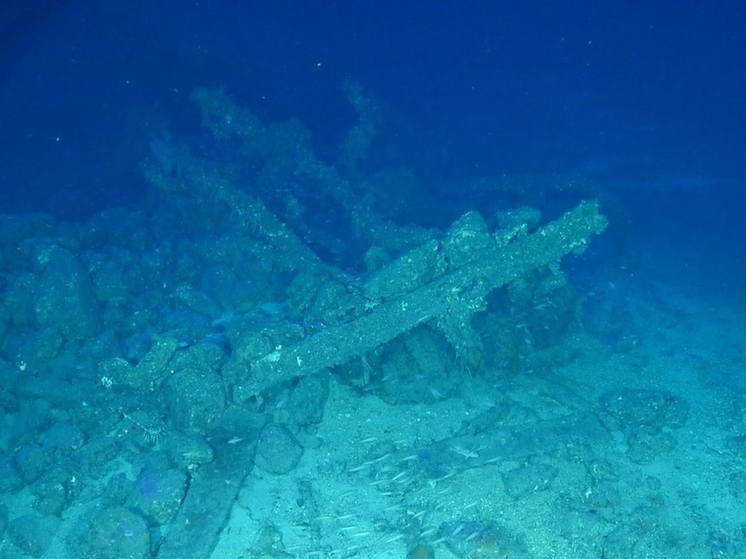Expedition used remotely operated deep-sea submersibles
An international team of scientists discovered three historic shipwrecks during an underwater archaeological expedition in the Mediterranean.
 Photo: unesco.org
Photo: unesco.org
The underwater expedition of archaeologists also collected high-resolution images of three Roman wrecks originally discovered by oceanographer Robert Ballard and archaeologist Anna Marguerite McCann in the 1980s and 2000s. The researchers' findings were presented on Thursday during a UNESCO press conference in Paris.
According to CNN, twenty scientists from Algeria, Croatia, Egypt, France, Italy, Morocco, Spain and Tunisia set off on a French research vessel» «Alfred Merlin» on a 14-day trip between August and September.
Using remotely controlled underwater vehicles, the researchers explored the banks of the Scherka in Tunisia and the Sicilian Canal in Italy.
The team used the survey vessel's underwater mapping equipment to catalog shipwrecks from ancient times through the 20th century using sonar.
Remotely operated submersibles dived to depths inaccessible to humans to collect images and videos of the wrecks ships and their artifacts. One of the vehicles was able to reach depths of 2296 to 2952 feet (700 to 900 meters).
Located along a busy route in the Mediterranean Sea, Skerki Bank in the Sicilian Strait is considered one of the most dangerous maritime areas. Its shallow waters feature a heavily rocky seabed, some of which are less than 3.2 feet (1 meter) below the water surface.
For more than 3,000 years, the dangerous features of the Skerka coast have led to shipwrecks, sinking of ancient merchant ships, as well as ships during the Second World War. The area is of interest to researchers because the route served as a point of contact between different cultures crossing the Mediterranean, says CNN.
The wreck was discovered at a depth of about 1,350 feet (411 meters) and was captured on sonar pictures. The researchers intend to return next year with a remotely controlled underwater vehicle to capture the crash site.
One of the vehicles descended into the most dangerous area of the Skurkey Bank, called the Whale Reef, to conduct the first detailed study of the ocean floor. Three ships, all previously unknown to researchers, rested at the bottom of the Tunisian continental shelf.
Two of the wrecks were likely from the late 19th or early 20th century, including a «large motorized metal wreck»; without any trace of cargo. In this wreck, investigators noted that davits that could have been used to launch lifeboats were facing outward, meaning the crew may have been able to abandon the ship. The second ship was most likely a wooden fishing boat.
The third shipwreck is likely related to a merchant ship that sailed between the first century BC and the second century BC. A remotely operated underwater vehicle spotted artifacts that appeared to be amphorae or tall, double-handled, narrow-necked jugs used by the Greeks and Romans, possibly to store wine.
The team hopes that browsing through the archives will help identify the individual names of the wrecks, as none of them were easily identifiable.
Meanwhile, exploration on the Italian continental shelf has unearthed three Roman shipwrecks dating back to between the first century BC and the 1st century BC, including two merchant ships and one cargo ship. Artifacts from all three ships are scattered across the seabed, including amphoras, pottery, building materials, jugs, pots and lamps.
These items were likely part of the trade between cultures that crossed the Mediterranean thousands of years ago, notes CNN.
“We are going to write a new page in the history of trade”, said Barbara Davidde, underwater archaeologist and director of the national Office of the Underwater Cultural Heritage of Italy. — Thanks to the analysis of the cargo, we can study the relationship between the countries of the Mediterranean and the maritime trade that connected the various parts of the Mediterranean”.
Surprisingly, the wrecks and their artifacts have remained virtually unscathed since they were discovered between 1988 and 2000.
The wrecks were originally located outside the territorial waters, which meant that their artifacts were easy prey to plunder. The areas around shipwrecks will now be protected in accordance with the 2001 UNESCO Convention Concerning the Protection of the Underwater Cultural Heritage.
This designation will allow for more accurate mapping of shipwrecks and protection zones.
&ldquo «We recognize the enormous potential and importance of underwater cultural heritage,» said Lazar Eloundu Assomo, Director of the UNESCO World Heritage Centre. – UNESCO has made an active commitment to support these types of underwater archaeological missions around the world. As you know, the Mediterranean, with its very rich history, countless shipwrecks and archaeological sites, is a unique and fascinating platform for such expeditions”.


